 Teleskop-Selbstbau Reiner Vogel
home
Teleskop-Selbstbau Reiner Vogel
home
Deep Sky and Polarized Light
A tour of proto-planetary nebula,
proto-stellar dust and synchrotron radiation
There are several stages during the life of a
star, during which its light, reaching us either directly or indirectly, is at
least partially polarized. One of these stages is the pre-main sequence stage,
when the newborn star is still surrounded by its partly very dense proto-stellar
disk, which reflects the light of the star at least partly in a
polarization-dependent manner. Another stage is at the end of the star's life,
after the outer parts of its atmosphere are blown of and the star is collapsing
to a white dwarf. For a short time, the white dwarf is not yet hot enough to
ionize the blown-off atmosphere and to form a planetary nebula. During this
intermediate stage, light from the star is merely reflected by these outer
shells, forming a so-called proto-planetary nebula (protoPN). The radiation
reaching us from the protoPN is also partially polarized. Another source of
polarized light are young supernova remnants (SNRs), such as the crab nebula. In
the SNR, fast (relativistic) electrons are trapped in strong magnetic fields and
emit polarized synchrotron radiation.
To detect polarization in the light of the
deep sky objects, I use a linear polarizing filter, fitted with a 48 mm thread
(compatible with the regular thread of 2" filters), which can be bought for
small money from photo equipment stores. For use with 1.25" eyepieces, the
filter is threaded into the bottom thread of my 1.25 to 2" reducer. With the
locking screw of the focuser not completely tight, the reducer (and the
eyepiece) can be rotated within the focuser and hence the direction of
polarization of the transmitted light.
Here are a few observations of the past few
years performed with the polarizing filter. A nice introduction to protoPN can
be found on the web site of
Martin
Schönball and a pdf file with finder charts is
here.
|
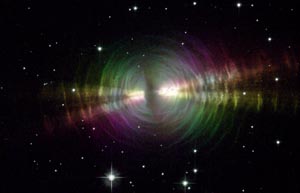
www.stsci.edu
|
The
egg
nebula
(CRL 2688) is a protoPN in Cygnus and the paradigm for polarization.
During conditions of good seeing I could easily discern the asymmetric
bipolar structure using my 14" Dob on a tracking platform. At 500x, the
protoPN responded nicely to the different filter settings, with the
intensity ranging from 100% to maybe 30% between the two extremes. |
|
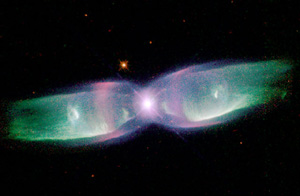
www.stsci.edu
|
The
butterfly nebula
(Minkowski 2-9) is another protoPN in Ophiuchus and could be observed with
my 22" Dob without filter as a small, faint, and elongated bipolar nebula
around a relatively bright central star. With the filter in place, small
variations of the intensity were suspected for different settings. The
relative brightness of the central star made it, however, difficult to
nail down these slight variations. |
|
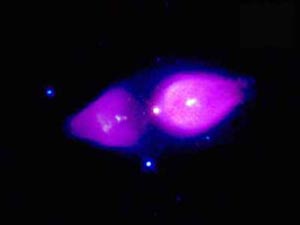
www.stsci.edu
|
Minkowski's footprint
(Minkowski 1-92), protoPN in Cygnus, revealed during very good
seeing at 900x with my 14" Dob a drop-like shape of the brighter one of
the two lobes of the bipolar nebula, while the "heel" of the footstep
could not be discerned. Both lobes could be seen during later observations
with my 22" Dob under similarly good conditions. In contrast to the two
other protoPN, no distinct polarization could be detected, which is in
line with the observations by Martin Schönball (see above). |
|
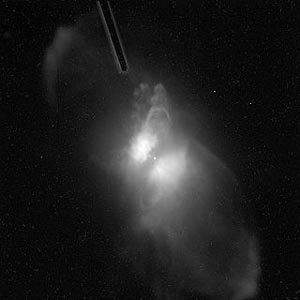
www.stsci.edu
|
Frosty Leo
(IRAS 17150+1212), a protoPN in Leo, revealed at 550x with my 22" Dob a
very small elliptic disk. Unfortunately, I forgot to check for
polarization at that time, but I'll catch up on this another time. |
|
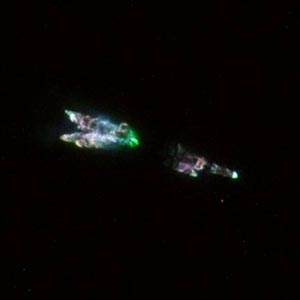
ESA & A.G.G.M. Tielens
(SRON/Kapteyn
Astronomical Institute)
|
The
Westbrook nebula
(CRL 618) in Perseus is the last of the protoPNs here. The object is
extremely faint and could be seen with my 22" at 500x intermittently with
indirect vision without any details. Polarization could therefore not
be checked for reliably.
|
|
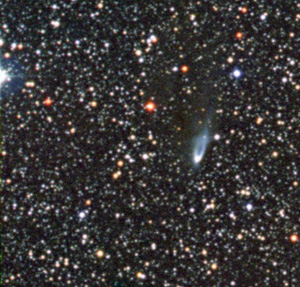
DSS
|
Parsamian 21
is a cometary reflection nebula, similar to Hubble's variable nebula,
Hind's T Tauri nebula, or McNeil's nebula in M78 (all T Tauri or FU Ori
type pre-main sequence stars). It is illuminated by the proto star (here
probably a FU Ori) hidden deep in the proto stellar dust disk. With my 22"
Dob, the nebula could be seen easily, revealing its elongated shape.
Despite that polarization is reported in the literature, I could not
discern any polarization-dependent alterations at the eyepiece. |
|
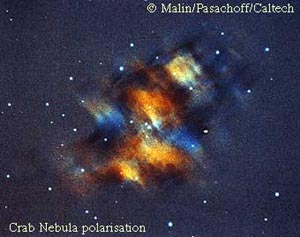
AATB,
Caltech, David Malin, Jay Pasachoff
|
Stimulated by pictures in Burnham's
Celestial Handbook, I tried to detect polarization in the light from the
crab nebula.
In Burnham's classic, there is a series of polarization-dependent
exposures. While these images reveal quite distinct changes of both shape
and internal structure, these changes are only very subtle at the eyepiece
and difficult to grasp. This is not astonishing as the white light
synchrotron nebula is relatively unstructured (in contrast to the
line-emitting filaments). The most distinct polarization-dependent changes
could be made out at the ends of the Z-shaped nebula. |
All observations would be performed without
the use of further filters, such as OIII, UHC, or H beta, which are useless for
reflections nebula.

home






